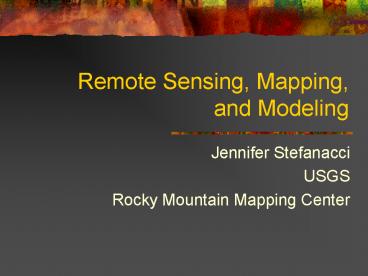Remote Sensing, Mapping, and Modeling - PowerPoint PPT Presentation
1 / 20
Title:
Remote Sensing, Mapping, and Modeling
Description:
Rocky Mountain Mapping Center. USGS Remote Sensing and Invasive Species ... Final Trend Surface Map. Model Output GIS Map. See Schnase et al. 2002, Kalkhan et al. 2003 ... – PowerPoint PPT presentation
Number of Views:182
Avg rating:3.0/5.0
Title: Remote Sensing, Mapping, and Modeling
1
Remote Sensing, Mapping, and Modeling
- Jennifer Stefanacci
- USGS
- Rocky Mountain Mapping Center
2
USGS Remote Sensing and Invasive Species
- Remote sensing of invasive species
- Identification of tamarisk and other species
- Inventory and survey designs at multiple scales
- Models to link various studies across scales
- Case studies rather than integrated program
- Integration is possible
- Coordination
- Infrastructure
- Sharing of ideas and data
3
Distribution of Tamarisk
- Develop a current, accurate map of tamarisk in
western North America - The last comprehensive map was published in 1965
- USGS (National Institute of Invasive Species
Science (NIISS) and Geography Discipline) along
with NASA will apply state-of-the-science remote
sensing - Initially along a reach of the Colorado River in
western Colorado
4
Distribution of Tamarisk
5
Environmental Factors Controlling Tamarisk
Distribution
- USGS-FORT Riparian Ecology Project
- Collected data on the distribution of tamarisk at
500 riparian sites in western North America - Future work
- Collect water salinity data at these sites
- Develop statistical models relating distribution
to stream flow, climate, and water chemistry - Create models and tools to prioritize sites for
control and restoration efforts
6
Environmental Tolerances of Tamarisk at the
Margins of Its Range
- Predict areas of tamarisk expansion
- Efforts to manage expansion of tamarisk would be
enhanced by accurate predictions of the likely
limits of its ecological niche - USGS-FORT Riparian Ecology Project will examine
the physiological tolerances of tamarisk through
a set of experiments
7
Modeling the Future Spread of Tamarisk
- The USGS NIISS and Geography Discipline will use
remotely sensed data and spatial modeling
techniques - Map current distributions
- Forecast potential distributions
- Define corridors and barriers to invasions
- Develop probability-based survey programs to map
and monitor early invasion and previously
infested areas
8
Advancing Predictive ModelingNASA Bringing
Supercomputing to the USGS Understanding
spread, risk, and barriers to invasion
Input Variables
Trend Surface Analyses with Stepwise Multiple
Regression
Final Trend Surface Map
Model Output GIS Map
NO
Is there Spatial Autocorrelation in the
Residuals?
Are Residuals Cross-Correlated with Other
Variables?
YES
Co-Kriging
YES
NO
Kriging
See Schnase et al. 2002, Kalkhan et al. 2003
9
Tamarisk Identification and Mapping Using
Remotely Sensed Data San Juan County, Utah
- USGS Rocky Mountain Mapping Center
- BLM Monticello Field Office
10
Background
- BLM Field Office oversees weed control program
- Limited funding
- Large area
- Need to focus control efforts
- Working with USGS to identify areas best suited
for control efforts
11
Requirements
- Short turn around time
- Cost-effective data
- County-wide coverage
- Repeatability
12
San Juan County, Utah
13
Comb Wash
14
Comb Wash
15
Goals
- Determine suitable data sources
- Perform baseline mapping
- Document procedures
- Training for BLM staff
16
Data Sources
17
Data Sources
18
Data Sources
QuickBird 2 foot
Digital Airborne Imagery 6 inch
19
Summary
- USGS working with BLM to identify and map
tamarisk - Remotely sensed data
- Cost and time effective approach
- Repeatable procedures
20
Conclusion
- USGS is currently using remote sensing and
modeling - Identification and distribution mapping
- Inventory and survey designs
- Models to predict future conditions and link
information across scales - Collaboration within USGS and with partners































